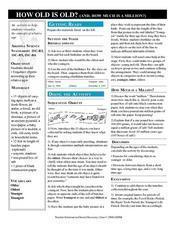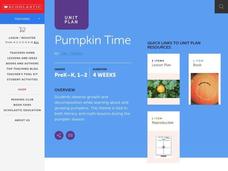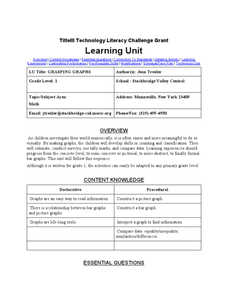Curated OER
Review Game
Students of all ages and subjects can participate in this review game. They are given a note card with a question or problem. The game is over when students have no more questions to answer.
Curated OER
Sampling Rocks
Students collect and sort rocks based on visible characteristics. For this statistics lesson, students determine adequate sample size and categorize rocks based on characteristics. The book Everybody Needs a Rock is read to...
Desert Discoveries
How Old is Old? (And, How Much is a Million?)
Here is an interesting lesson on how old things are designed for young scientists. In it, learners compile a list of their birthdays, and the class puts them in sequential order from youngest to oldest. Then, they sequence 15 objects...
Curated OER
Look at Those Leaves!
Students observe leaves. In this math and science cross-curriculum leaf instructional activity, students take a nature walk and collect leaves. Attributes are assigned and leaves are sorted in various ways. Students use non-standard or...
Manitoba Education and Early Childhood Learning
A Foundation for Implementation
Color is the focus of this amazing resource packed with math, social studies, science, and language arts activities. Kids create a color word wall and post symbols, graph the number of objects they find of each color while on a...
Curated OER
Monarch Chrysalis
Learners examine the last stage of the monarch butterfly. In this life cycles instructional activity, students read the book The Very Hungry Caterpillar and study photos of the monarch life cycle. Learners illustrate the third stage of...
Curated OER
Ramps
Students experiment to see how various objects roll down ramps. In this ramp lesson, students observe weight, size, and material of objects. Students compare speeds by using a second ramp.
Curated OER
Storms and Extreme Weather
Students explore hurricanes and tornadoes by conducting an experiment. In this weather pattern lesson, students define many extreme weather vocabulary terms and discuss the relationship with static electricity. Students utilize plastic...
Curated OER
Pumpkin Time
In these two lessons, science learners participate in various activities involving pumpkins. They investigate and research the life cycle of a pumpkin. They observe pumpkin growth and decomposition. Finally, they estimate and measure...
Baylor College
Do Plants Need Light?
Turn your classroom into a greenhouse with a lesson on plant growth. First, investigate the different parts of seeds, identifying the seed coat, cotyledon, and embryo. Then plant the seeds and watch them grow! Measure the new plants...
Curated OER
Flight Dreams - Folding into Flight
Combine measurement, following directions, physics, and art with one fun activity. Learners read a set of instruction to create three different kinds of paper airplanes. They measure, fold, and fly the planes, and record data and answer...
Advocates for Human Rights
The Right to a Clean Environment: Water
First, young citizens learn about water consumption by doing some research themselves on their home water usage and sharing their findings with the class. Then, they do some brainstorming and devise a plan to reduce water consumption.
Curated OER
Volcanoes: First Grade Lesson Plans and Activities
Introduce young geologists to types of volcanoes during the pre-lab. First graders explore how different liquids flow with an experiment on viscosity to simulate how different types of lava flow. Next, they learn...
Curated OER
Making Estimations in Measurement
Students utilize their knowledge of measurement in making accurate measurements and estimations.
Curated OER
Problem Solving
First graders explore problems and solutions. In this math lesson plan, 1st graders brainstorm problems they have encountered and how they solved them. Then students watch a video about how professionals solve problems. After sharing...
Curated OER
What Makes Ten
Students investigate the concept of ten and how it is part of the real number system. They find the quantity of ten using as many combinations as possible. They can count using manipulatives, write on paper, or by doing mental math.
Curated OER
Making Estimations in Measurement
Students explore estimating and measurement with the story of Jack and the Beanstalk. They read and discuss the story, estimate and measure their own height, circumference, and length of their foot, and draw and paint a giant using...
Curated OER
Technology Literacy Challenge Grant Learning Unit
First graders explore counting and classification. They sort leaves, create graphs, write sentences for the data in the graphs, develop graphs for shapes, favorite animals, birthdays, and participate in a die prediction game.
Alabama Learning Exchange
The Grouchy Ladybug
Learners listen to the book, "The Grouchy Ladybug" by Eric Carle and sequence the events in the story. Using a graph, they draw and color the animals that the ladybug meets next to the corresponding time from the story, and conduct...
Curated OER
Where are all the Animals?
Students view animals that camouflage at the Shedd aquarium website. In this camouflage lesson, students recognize that there are different types of camouflage, cryptic coloring, counter-shading, warning coloration and mimicry. Students...
Curated OER
Time Battleships
Students play a game to practice how to tell time. They play a game of battleship in which they try to find out where his or her partner's battleships are, using .day/time references. The winner is the first to find all of the other...
Curated OER
Beautiful Bugs
Students investigate the life cycle of ants, ladybugs, and butterflies. They list the four stages of the butterfly life cycle, define symmetry and observe how ants make homes in dirt.
Alabama Learning Exchange
A Rockin' Investigation
Young scientists identify the rock cycle. In this earth science activity, students participate in web-based research to understand how sedimentary, metamorphic, and igneous rocks form. As a follow-up, they collect various rocks and...
Curated OER
Creating AB Patterns
Students work with patterns. In this pattern lesson, students find AB patterns in nature and the manmade world. They create their own AB pattern using math manipulatives and visual arts.























